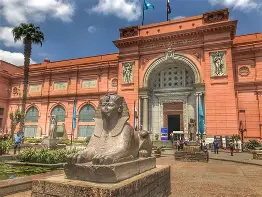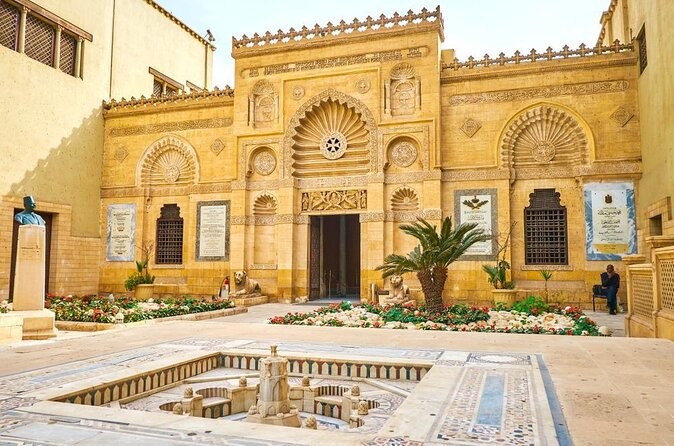Cultural, historical, adventure, and custom customized trips are just a few of the tours that Deluxe trips offer in Egypt and Jordan.

We at Deluxe Tours take you on a journey through Cairo's most fascinating museums—each one of which holds epochs and stories that span millennia. From pharaonic relics to royal palaces, these nine museums reveal Egypt's history in its resplendent glory.
Scheduled to be the biggest archaeological museum in the world, GEM lies only 2 km away from the Great Pyramids. It contains more than 100,000 artifacts, such as the entire Tutankhamun collection—a historic reunion of over 5,600 objects for the first time in recent history. A massive statue of Ramses II greets the visitors at the Grand Staircase under a majestic atrium. The site includes the world's largest conservation center with 19 specialized labs working on restoration and research. While all the galleries have opened to visitors since 2024, the official formal opening is yet to happen. GEM features ultra-contemporary design, interactive exhibits, children's zones, restaurants, cinemas, and outdoor spaces to deliver an integrated visitor experience.

Opening in April 2021 with the iconic Pharaohs' Golden Parade, NMEC showcases Egypt's continuity from prehistory to Pharaonic, Greco-Roman, Coptic, Islamic, and modern times. This trailblazing museum houses more than 50,000 objects and organizes its collections in theme and chronological galleries, including the Royal Mummies Hall, textile, and Nile‑culture galleries. The structure itself houses a pyramid‑shaped Panorama Hall consisting of 3D screens narrating Egyptian history in interactive way. Visitors also enjoy theaters, cinemas, laboratory research space, and outdoor performance areas, all situated along Fustat's ancient lake.

Besides Cairo's finest museum (founded in 1902), the Egyptian Museum still houses some 170,000 antiquities. Although many of its landmark items have been relocated to GEM and NMEC, its galleries remain packed with treasures like the original King Tutankhamun mask, canopic jars, and statuary spanning the Old Kingdom through the Greco-Roman period. Many here are given no explanation, so it is best to go with an informed guide so one can appreciate the scope of the collections.
Admired as the world's greatest Islamic art museum, it holds over 100,000 items from ceramics through to glass, crystal, metalwork, fabrics, and valuable manuscripts—a few written in silver pen with gold borders. Its own history is problematic too: a car bomb in 2014 detonated on the pavement outside and destroyed the frontage and artefacts, many of which needed restoring. It was opened in 1903 and refurbished in 2010, and it's a destination for academics and art lovers alike.

A storeroom for the world's largest collection of Coptic Christian artifacts, the museum contains over 1,600 items such as deerskin bibles of centuries past, papyrus inscriptions of early centuries, fabrics, and iconography dating back to as early as the 3rd century AD. It is situated in the ancient labyrinth of Coptic Cairo, close walking distance of famous churches such as the Hanging Church and St. George's Church. This is a museum one ought to see to gain insight into Egypt's Christian past and early religious growth.

Set in a beautifully restored 17th-century Ottoman house next to the Ibn Tulun Mosque, this museum is in honor of Major Robert Gayer‑Anderson, who lived here in the 1930s–40s. Extremely personal in its explanation of Islamic design and architecture in carpets, furniture, pottery, calligraphy, and souvenirs from around the Islamic world, it's a marvelous primer on the topic. Each room leads out into a new cultural influence, and the house itself is a work of art of design and restoration.
![Gayer Anderson Museum [The Art Museum in Sayyida Zeinab]](https://mlrhpz8jmuut.i.optimole.com/cb:Ie5o.50122/w:auto/h:auto/q:mauto/ig:avif/f:best/https://www.egypttoursplus.com/wp-content/uploads/2018/05/Gayer-Anderson-Museum.jpg)
A quintet of museums in the old royal palace, Abdeen is a virtuoso of variety:
Arms Museum: Displays decorated arms—such as Muhammad Ali and Napoleon Bonaparte's decorated swords to European ceremonial gun collections.
Medals & Decorations Museum: Houses royal and state orders, cordons, and medals that had been bestowed upon Egyptian monarchs over the centuries.
Royal Family Museum: The personal belongings, clothing, silverware, and furniture of Egypt's royalty offer an insight into royal life.
Silverware Museum: Features dining sets, crystal, cutlery, and royal gifts in luxurious silver and gold craftsmanship.
Historical Documents Museum: Showcases rare decrees, correspondence, treaties, photographs, and albums—spanning Muhammad Ali’s reign to King Farouk.
The palace architecture that combines the Ottoman, European, and Arabic architectural styles is a historical treasure in today's Cairo. The royal gardens and Defender Square, which is lined with old cannons, complement the experience.
Built between 1875 and 1929 by Prince Mohamed Ali Tawfiq, the palace features Ottoman, Persian, Moorish, and European Rococo architectural forms. It contains royal collection artwork, manuscripts, costumes, silver items, furniture, and ceramics. Its pavilion-type buildings and gardens are among Cairo's most stunning historical settings. Notable are its mosque in Islamic design, elaborately adorned reception halls, and quirky hunting lodge.
Dedicated to Egypt's greatest singer Oum Kalthoum, this biographical museum is filled with memorabilia, discs, costumes, and a brief documentary film about her life and career. This is a small but powerful museum; viewed in half an hour and commonly accompanied by visits to the nearby Manasterly Palace and Nilometer. For the aficionado of Arabic music or cultural heroes, this museum is a moving tribute to a woman who captured a nation's voice.
These Cairo museums interweave Egypt's cultural fabric—from Pharaonic dynasties to Islamic art, Coptic heritage, modern royal existence, and musical heritage. They offer the unbeatable richness, epic narratives, and local context that give each artifact significance.
GEM: Royal extravagance and archaeological sweep.
NMEC: Civilization continuity spanning 7,000 years.
Tahrir Museum: Tradition, Tuts, and Tahrir's heritage.
Islamic Art Museum: Divine beauty in calligraphy, metalwork, and tile.
Coptic Museum: Christianity's roots in Egypt.
Gayer‑Anderson: A timeless site of Ottoman intimacy.
Abdeen Palace: Diplomacy, empire, and monarchical life in multidisciplinary disguise.
Manial Palace: Cultural eclecticism and artistic refinement.
Oum Kalthoum Museum: National sentiment, memory, and music.
Discover now our answers to the most common questions that may come to your mind about tourism and trips to Egypt
Cultural, historical, adventure, and custom customized trips are just a few of the tours that Deluxe trips offer in Egypt and Jordan.
The Dead Sea, Petra in Jordan, the Pyramids of Giza, Luxor's historic temples, and many other famous sites can be expected to be explored with Deluxe Tours.
offer a hassle-free holiday, Deluxe Tours' packages generally include lodging, transport, meals, guided tours with experienced local experts, and entry fees to attractions.
Spring (March to May) and fall (September to November) offer the finest weather for sightseeing and outdoor activities, making those months the best times to visit Egypt and Jordan.
These two countries are close by, only a 1.5-hour flight apart, and when combined, offer a variety of distinctive experiences. We advise you to spend at least 12 days visiting both countries for a truly unforgettable experience
Combining the eclipse viewing with visits to historic sites like the Pyramids of Giza, the Valley of the Kings, and a Nile River cruise are highly recommended.
